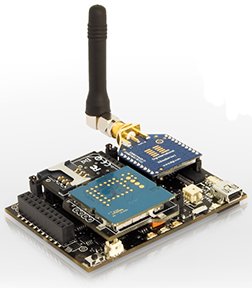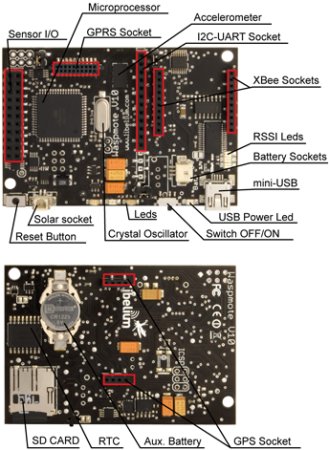Sensor mote platform offers Linux IDE
Dec 3, 2009 — by Eric Brown — from the LinuxDevices Archive — 15 viewsLibelium announced a ZigBee-enabled wireless mote-sensor platform with open source code and a Linux-compatible IDE. The Waspmote runs on an Atmel microcontroller, boasts low 0.7uA power consumption, provides 2.4GHz, 900MHz, and 868MHz radios, and offers add-ons for GPS, GPRS, and SD, as well as gas, events, and prototyping sensors.
Unlike Libelium's x86-based Meshlium multi-protocol mesh router or its outdoor-mountable N-Vio WiFi routers, the Waspmote does not run Linux. However, an open source API for C programmers is available with Linux, Mac, and Windows integrated development environments (IDEs), says the Zaragoza, Spain-based company.

Libelium Waspmote

Libelium's earlier SquidBee mote sensor
Like the Arduino modules and the SquidBee, the 2.9 x 2.0 x 0.5-inch (73.5 x 51 x 13mm) Waspmote main board is based on an Atmel microcontroller. The Waspmote offers an Atmel ATmega1281 microcontroller clocked at 8Mhz, with 8KB SRAM, 4KB EEPROM, and 128KB flash. The main board is also supplied with a 2GB SD flash card option.
The Waspmote is equipped with digital I/O (7 analog, 8 digital), plus a mini-USB port, and interfaces for PWM, I2C, and two UARTs, says Libelium (see detail chart below). Onboard sensors include a 3-axis accelerometer to measure ±2g and ±6g ranges, as well as a temperature sensor that can measure between -40 and 185 deg. F (-40 to 85 deg. C), with 0.25 C accuracy.

Waspmote main board details
Customers can choose from between seven "XBee" radios, equipped with external antennas. These include two standard 802.15.4 (ZigBee) radios and two ZigBee-Pro radios, all with 2.4GHz frequency. Offered in a variety of power configurations, the radios are provided in either 500-meter (1,640 feet) or 7km (about four miles) ranges.
The other three radios are standard RF models operating at 868MHz and 900MHz, offering ranges between 10km (about 6.2 miles) and for the 868MHz radio, 40km (about 24.85 miles).

Waspmote add-on sensor boards, left to right: gases, events, and prototyping
(Click to enlarge)
In addition to the XBee radios, users can buy optional GSM/GPRS and GPS modules, as well as a Waspmote gateway ZigBee radio that plugs into a PC via a USB connection. In addition, Libelium offers three add-on sensor boards:
- Gases — detects CO, CO2, CH4, SH2, NH3, and more, designed for pollution, farm/hatchery emissions, chemical process control, and forest fire control applications
- Events — detects weight, luminosity, tilt, vibration, PIR, liquid level, and more, designed for security, emergency response, and logistics control
- Protoyping — general purpose board for testing out new sensors, includes ADC, pad area, and amplification stage
Libelium offers open source programming and networking APIs and compilers for C programming. The company also offers IDEs for Linux, Windows, and Mac-OS.
Availability
The Waspmote appears to be available now, with pricing available on request. More information may be found here, and more on the API and Linux IDE should be here. A description of the differences between the SquidBee and the Waspmote should be here.
This article was originally published on LinuxDevices.com and has been donated to the open source community by QuinStreet Inc. Please visit LinuxToday.com for up-to-date news and articles about Linux and open source.